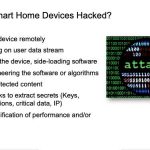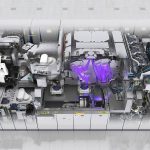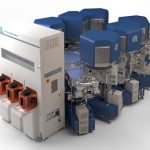The “20 Questions with John East” series continues
How did it end for Fairchild? Badly!!!
In 1966 Fairch was the number one supplier of integrated circuits. That was as it should have been. After all, Fairch had invented the IC. But in 1967 TI passed them. Still, Fairch remained a strong #2. By the time that the mid-seventies arrived, though, they were fading. Motorola and some others had passed them in sales by then. Fairch was clearly struggling and beginning to look like an acquisition target.
After some near-deals, Schlumberger bought Fairchild in 1979 for $425 million. Schlumberger was a very successful supplier to the oil and gas exploration industry. Over the years I’ve been really impressed with the way they’ve done business, but in this instance their past successes led to a terminal case of hubris. They put Tom Roberts, a financial type with no experience as a CEO and no semiconductor background either, in charge. He fared badly. Very, very badly!! The death march had begun! In 1985 Don Brooks, a well regarded TI executive, replaced Roberts as CEO, but the damage had already been done. Revenues continued to decline. Eventually, Schlumberger decided to sell. A Schlumberger spokesman explained, “Silicon Valley ain’t the oil business!” In came an offer from Fujitsu. The offer was for only $245 million – a small amount for a company with sales of $400 million annually, but Fairch jumped at it. Terms were agreed to — all that remained was government approval. It never came. The US government refused to approve the deal arguing that the sale of a technology company to a foreign entity was not in the best interests of the United States. In the end, Fairch agreed to sell themselves to National Semiconductor at the shockingly low price of $122 million. To put that in perspective, today TI is valued at $110 billion and Intel at $210 billion. — at its death bed, Fairchild was worth about 1/2000 the value of Intel today.
Fairchild started out as the king of the hill. The darling of Wall Street. They ended up virtually worthless.
Note: National spun out a “new” Fairchild in 1997. It wasn’t the real Fairchild. They got out of the traditional IC rat race and into new product categories. Power devices. Power discretes. Power analog. High voltage. Opto couplers etc. They were quite successful — this new “Fairchild” was a winner. The new management did a wonderful job!! But it was Fairchild in name only. It wasn’t even close to “our Fairchild”. The traditional IC inventor and powerhouse Fairchild was dead. It had died a slow and painful death.
Why? What happened? In my view there were three major causes.
#1. The exodus
Fairchild could never keep their most important people. Not long after the invention of the integrated circuit, internal strife broke out between some of the traitorous eight. The result was that four of them left in 1961 to found Amelco. Then, of course, Moore and Noyce left in 1968 to found Intel. The last of the eight to leave was Julius Blank in 1969. You’d think that there would have been great fanfare. There wasn’t. One day he was just gone.
The real personnel pirate when I first got there, though, was National Semiconductor. In 1966 Charlie Sporck left his job at Fairchild to head up National. A short while later Charlie recruited a trio of top Faichild managers including Pierre Lamond. (Pierre eventually became a huge success in the venture capital field. Today he’s a partner at Eclipse Ventures. Pierre is 88 years old, but has a ton of energy!!) Over the next couple of years, many key managers and engineers left Fairchild to go to National. So —– Intel wasn’t public enemy number one when I got to Fairch — National was. But then Intel took their turn at raiding — and they did an excellent job of it!! Volumes of wonderful engineers and scientists made the jump to Intel. Eventually even AMD took a turn. Jerry Sanders and John Carey, of course, had been fired when Les Hogan came in — victims of “Off with their heads.” They went on to found AMD and, I’d imagine, took great delight when their turn came.
The bottom line — Fairchild just couldn’t hang on to their most important employees. The key Fairchild engineers usually ended up making huge contributions. — But – not at Fairchild.
#2 MOS happened
Fairchild started out using bipolar transistor technology. No surprise there. MOS was technically very conceivable in the early days, but in the real world it couldn’t be made profitably. The potential benefits of MOS were known, but always just out of reach.
In those days Fairch didn’t really understand mobile ion contamination. Or work functions. Or surface states. Or oxides. To grossly oversimplify, no one knew how to control the thresholds which moved substantially during life test. You couldn’t reliably turn off N-channel transistors. So — MOS at Fairchild in the early days was P-channel. And sadly, P-channel MOS was slow! There was one beautiful thing, though. PMOS was a five mask process. PMOS wafers were really cheap and easy to make so long as you didn’t mind bad sort yields and slow, unreliable parts.
CMOS had been conceptualized, but it seemed totally out of reach in those days. It was widely recognized at the Fairchild R&D facility in Palo Alto that there were solutions to these problems and that the upside of MOS (Particularly CMOS) greatly eclipsed that of bipolar. The roadmap was pretty clear: Get rid of the contamination. Make silicon gate work. Switch to CMOS. And finally, scale like crazy!! Scaling helps MOS greatly but helps bipolar only a little. The good news: that roadmap was followed and the problems were solved. The bad news: It didn’t happen at Fairchild. It happened at Intel. And AMI. And Micron. And Mostek. And many other companies. But Fairchild never really succeeded on the MOS battleground.
Somewhere around 1974, though, Fairchild came up with a counter-punch. The Isoplanar process. A team working under Doug Peltzer developed a new process for making bipolar ICs. The new process used oxide sidewall isolation instead of the traditional reverse-biased junctions. That would make the die a lot smaller and the parasitic capacitance a lot lower if only they could get the yields to a respectable point. After some tough battles with Iceo – the traditional bane of bipolar transistors — they did it. Ergo — faster and cheaper!! By quite a bit! Isoplanar bipolar technology staved off the MOS hoards for probably ten years longer than would have been the case otherwise. But the fabs kept scaling. Two microns went to 1.2, then to 1.0, then .8 then .5 etc etc. MOS kept getting better and better. Bipolar couldn’t keep up. Today for the most part bipolar is a thing of the past.
(Note: I was a bipolar transistor circuit designer. Guess that explains why I’m having such a hard time getting a job.)
#3. Product planning
In the late 90s we hired a consulting company at Actel. (Name withheld to protect the guilty.) After the normal lengthy and expensive consulting process, the consultants concluded that Actel was too focused on products. I grudgingly accepted that at the time, but I was wrong. The fact was, we weren’t focused enough on products. In the non-commodity IC world, your product is all that matters. Branding works well for Apple!! People will go out and buy a product just because it’s an Apple product. But, when you’re selling to Cisco, what they want is the best product for the job they’re trying to do. What does this have to do with Fairchild? Fairchild never put together a product planning system that really worked. Other than Isoplanar bipolar memories and a relatively small line of ECL products, they never seemed to innovate products that customers needed.
Proof of that came when Schlumberger took over Fairchild. They put a ton of capital into the company — rumors had it that Schlumberger invested the better part of a billion dollars after they bought the company. They bought better fab equipment and better testers. They improved their assembly lines. They also put more money into marketing and selling. But they didn’t have a significant product that the world needed. The capital spending was to no avail. Sales didn’t rise at all. In fact, they fell. No good products – no sales!
Long story short? Fairchild invented the integrated circuit and kicked off an industry that today hovers at around $400 billion annually. They were at the root of the creation of probably hundreds of successful companies and many thousands of millionaires. Along the way they helped create probably a few dozen billionaires as well. But, when the dust settled, Fairchild had failed. They were worth next to nothing and the dregs that had some minuscule value lay in the hands of their once most despised competitor.
And Sherman Fairchild turned over in his grave.
Next week: AMD and some Jerry Sanders stories. (TJ Rodgers too!!)
See the entire John East series HERE.








